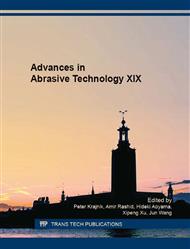p.3
p.9
p.15
p.22
p.28
p.34
p.40
p.46
Simulation Research for the Effect of KDP Crystal Defect and Initial Internal Stress on Sawing Stress
Abstract:
KDP (KH2PO4) crystal is a kind of excellent nonlinear optical crystals, which has been widely used in nonlinear optical and Inertial Confinement Fusion (ICF) engineering. KDP crystal with the characteristics of low hardness, high brittleness, easy deliquescence and temperature-sensitive is easy to crack during the crystal growth, taken out from crystallizer, and the process of slicing. Stress concentration caused by the initial internal stress redistribution and the growth defect in KDP crystal is an important reason of KDP crystal cracking during sawing process. The numerical simulation model of the KDP crystal containing spherical cavity defect and sawing with fixed abrasive wire saw is established by finite element method in this paper. The effects of initial internal stress, spherical cavity defect on sawing stress are investigated. The maximum tensile stress near the defect during the sawing process is simulated and analyzed. The results show that sawing stress changes smoothly during sawing process, and the fixed abrasive wire saw slicing belongs to low stress cutting way. The sawing stress at sawing kerf is increased obviously. The crystal defect leads to local stress concentration during sawing process. The coupling effect of sawing stress with initial internal stress and the effect of stress concentration are enhanced when the sawing kerf approaches to the defect.
Info:
Periodical:
Pages:
9-14
Citation:
Online since:
October 2016
Authors:
Price:
Сopyright:
© 2016 Trans Tech Publications Ltd. All Rights Reserved
Share:
Citation:


